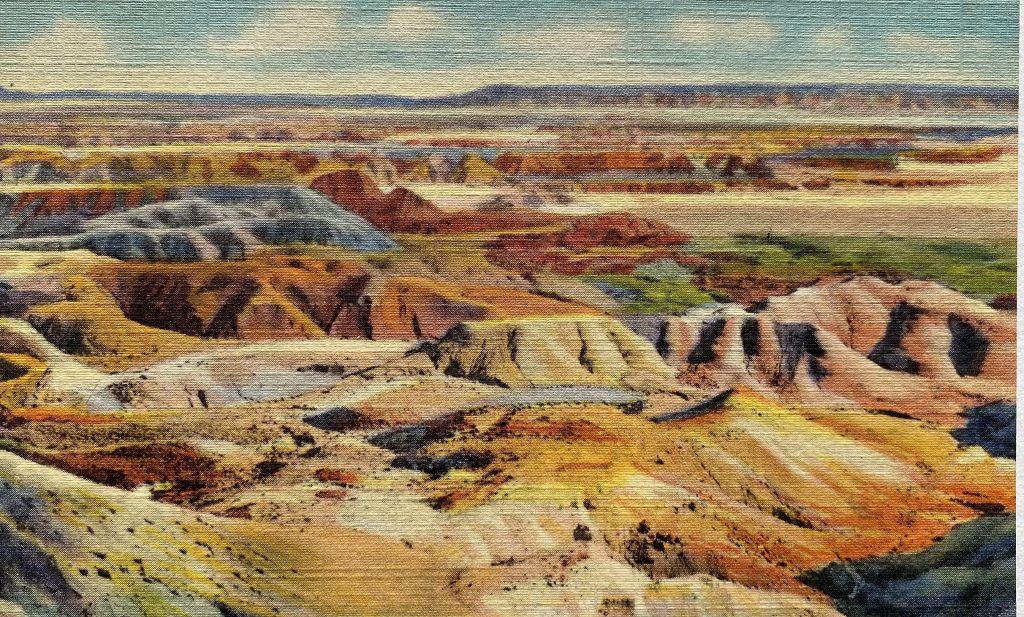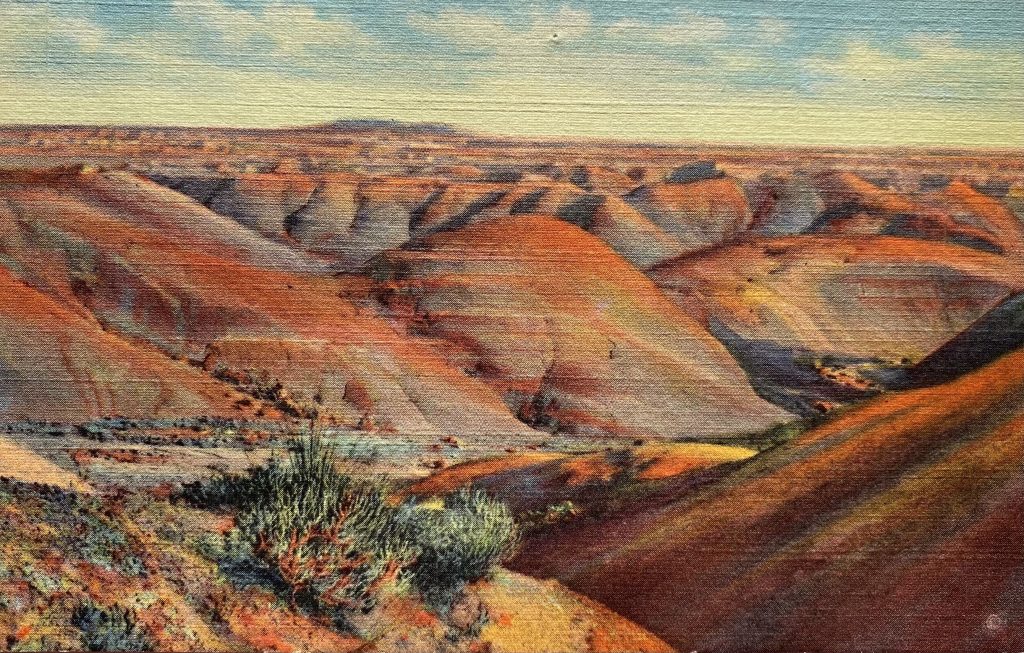Anne Ross
The Curse that Rocks the Petrified Forest

Arizona’s Petrified Forest National Park and the Painted Desert contained within it are two popular tourist sites in an area sacred to indigenous peoples. Two series of linen postcards published by Curt Teich showcase the beautiful landscape that has attracted visitors for more than one hundred years. Ironically, the beauty of this land led to both the preservation and the destruction of the area’s natural history. If you visit, you will be warned not to pick up fossilized “souvenirs.” Ignore these warnings at your peril – as many visitors discover after leaving this ancient site.
One hundred ninety million years ago a forest died here. Then a volcano erupted, covering the fallen trees with ash. Over the years, moisture seeped into the ash-covered trees. A chemical reaction took place that turned the trees to stone. Hence the name Petrified Forest. Only the trunks of fossilized trees and bits of petrified wood remain.


Today, the local Navajo refer to pieces of petrified wood as “Yei-bits-in.” Traditionally, they are believed to be the bones of Yei-tso, the largest, most powerful, and most feared of the Anaye, or alien gods. Yei-tso’s father was a stone, so his body was covered with bits of shale and flint. He met his death at the hands of legendary hero twins. Yei-tso’s bones were scattered and some landed in the area now known as the Petrified Forest. According to the Navajo, the bones of Yei-tso are sacred. Unfortunately, tourists have long been unaware of this.
In 1906, President Teddy Roosevelt made the petrified forest a national monument and tourists began to visit in droves. Disregarding the park rules, they often picked up bits of fossilized wood as souvenirs. If the tourists had been aware of the Navajo traditions, they might have chosen to leave Yei-tso’s bones alone.
About twenty-five years after the park opened, tourists began reporting that ill fortune followed the petrified wood they had pilfered. In 1930, the visitor’s center received its first “conscience letter” from a tourist who reported adverse life events after pilfering a bit of petrified wood from the park. Currently, the visitor’s center has about 1,000 conscience letters detailing deaths, relationship breakups, job loss, illness, and injuries after visiting the park. Most of the tourists’ letters read something like this: “I’m sorry I took this rock. Ever since I took it, I’ve been plagued by bad luck. Please take it back!” This phenomenon became known as the curse of the petrified forest.

The tourists tried to undo the curse by returning the “rocks” so they could be put back where they came from. However, park rangers had no idea where each piece came from. So the bones of old Yei Tso could not be returned to their original resting spots. The tourist center was faced with a dilemma. What should be done with all these pieces of petrified wood?
To solve this issue, the visitor center’s administrators decided to treat their problem as an opportunity. A display was created showcasing the conscience letters and bits of petrified wood returned by tourists. Perhaps educating them would help preserve the petrified forest. Then in 2011, artist Ryan Thompson set up a website entitle Bad Luck, Hot Rocks. To publicize the letters, three years later, the same title was used for a book written about the rocks. Publicity has slowed the tide of conscience letters, but the visitor’s center still receives three or four a month.

Sadly, the tourists’ letters have received more attention than the pilfered petrified bits of Yei-Tso’s bones. They lie in a huge heap that is maintained out of the public eye. Whether or not Yei-Tso is still angry about the disrespect paid to his fossilized bones is uncertain. That is best determined by the Navajo people. For the rest of us, it’s best to remember that it is unwise to remove anything from a national park or an area that is sacred to indigenous peoples.
Postcards make better souvenirs!

FIVE ILLUSTRATIONS
From the Author’s Collection
First: “The Painted Desert.” Linen postcard, C.T. Art-Colortone, published by Curteich, Chicago Illinois. copyrighted & distributed by J.R. Willis, Albuquerque, New Mexico. Painted Desert series #P.D.12.
Second: “Painted Desert, Arizona.” Linen postcard, C.T. Art-Colortone, Curteich, Chicago Illinois. Copyrighted & distributed by J.R. Willis, Albuquerque, New Mexico. Painted Desert series #P.D.14.
Third: “Petrified wood and erosions, Petrified Forest, Arizona.” Linen postcard, C.T. Art-Colortone, Curteich, Chicago Illinois. Copyrighted & distributed by J.R. Willis, Albuquerque, New Mexico. Petrified Forest series #P.F. 30.
Fourth: “Cross-section of petrified logs, Petrified Forest, Arizona.” Linen postcard, C.T. Art-Colortone, Curteich, Chicago Illinois. Copyrighted & distributed by J.R. Willis, Albuquerque, New Mexico. Petrified Forest series #P.F. 43.
Fifth: The Rainbow Desert Museum in the Petrified Forest National Park. Site of the “hot rocks” exhibit.
Never heard of this specific curse before, although I’ve read plenty of cautionary tales about disturbing old Indian burial grounds.
What a great story about Yei-Tso’s bones reaching into the future to enact revenge. The cards are beautiful but who would think they had such an interesting story. I enjoyed this article.
In my collection, I have a piece of Petrified wood very heavy, about 10 inches long.